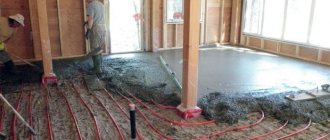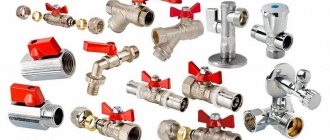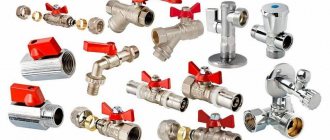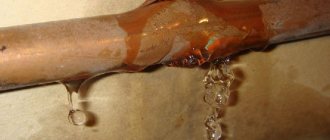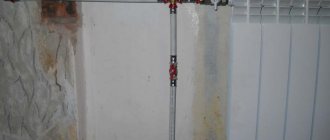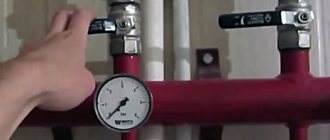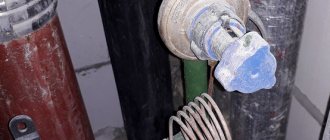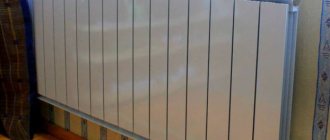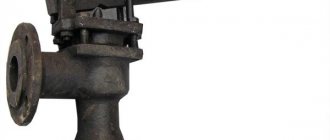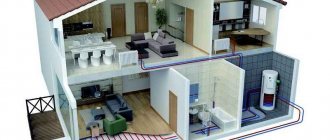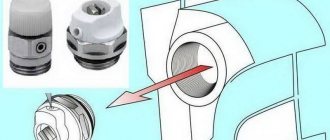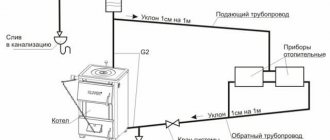Heating a home is necessary in our climate. Usually ready-made radiators are installed. But sometimes a situation arises when it is necessary to heat a garage, greenhouse, or workshop. A standard radiator will get dirty very quickly; moreover, due to the complexity of its design, it is difficult to clean it from dust. Sometimes you just want to save money and make a heating device from scrap materials.
We welcome our esteemed regular reader and offer him an article about what heating registers are available and how you can make them yourself.
What are they and what are they for?
In the traditional sense, a heating register is a heating device made of several connected pipes or one curved round pipe. In apartments, snakes made of inch pipes with mounted curved plates made of steel sheet are more often found. In factories and some public spaces, registers are made of smooth pipes with a diameter of 60 mm or more.
Batteries previously had no aesthetic properties at all.
Such heating devices were used for three reasons:
- The cost of pipes is less than cast iron radiators.
- Smooth-tube registers can be made from pipes of any diameter on your own and placed in a convenient place. Almost every organization, starting with the housing office, had a welding machine and a welder; the problem of heating workshops, garages, and utility rooms was quickly resolved.
- Registers were often used in workshops due to the dustiness and slightly higher strength of steel compared to cast iron (more precisely, due to greater ductility and less fragility). In dusty production, cleaning radiators is difficult, but smooth pipes can be washed without problems. Steel is also preferable if there is a risk of damage to heating devices by cargo or transport. In addition, cast iron bursts when it freezes; steel pipes do not always burst; cracks are easy to weld; Often frozen steel registers are warmed up even with an open fire.
Modern heating registers in homes are most often used as interior decoration - modern ready-made purchased or exclusive designer devices are very decorative.
It is especially worth noting heated towel rails - they are an integral attribute of heating and comfort in bathrooms.
Classic designs of heating registers
Option #1 - horizontal register
Most often, when manufacturing a heating register, two or three parallel pipes laid horizontally are connected. The distance between adjacent sections in the register must necessarily be 50 mm greater than the diameter. Coil designs of registers are also popular, divided into several types depending on the method of connecting devices to the heating system.
Heating registers of coil type: L - length of the heating device, D - pipe diameter, h - distance between pipes (50 mm greater than the diameter)
The length of the heating devices is selected in accordance with the dimensions of the room or room in which it is planned to install the heating system. In addition to the listed types of heating register designs, there are also:
- single-pipe products;
- four-pipe devices;
- five-pipe models, etc.
The number of pipes used in one heating register depends on the area of the heated room, the quality of the object’s thermal insulation, the presence of other heat sources in the room, etc. By sorting through the possible pipe diameters, the optimal dimensions of the products are calculated, at which the optimal temperature regime will be maintained in the heated room.
Horizontal heating registers made of smooth pipes are used for lower piping. In this case, the products are carefully placed around the perimeter of the room closer to the floor surface. In a residential building, pipes go under the windows. In industrial premises, the location of heating devices depends on the height of the ceilings, the layout of the facility and the placement of industrial equipment.
Heating registers successfully heat social facilities. Caring for such heating devices is much easier than cast iron radiators.
Option #2 - vertical registers
When remodeling apartments and expanding their living space with balconies and loggias, it is necessary to dismantle the batteries installed by the developer when handing over the property. In this case, the dismantled radiators are replaced with vertical heating registers welded from a large number of round pipes of small diameter. These heating devices are placed in a wall located next to the window opening.
If necessary, vertical heating registers are covered with decorative grilles, which turn an essential element of the heating system into an interior decor item. You can disguise the location of the “bundle” of parallel pipes using mirrors, colored glass, mosaics, wrought iron grilles, as well as by placing shelves, hangers, cabinets and other useful items of non-bulky furniture.
It is possible to ensure the movement of coolant in a vertical register installed in an autonomous heating system of a private house using a circulation pump. Horizontal registers are also used for natural coolant circulation, if they are installed with a slight slope (0.05% is sufficient).
Types and technical characteristics
There are many modern varieties of registers: from traditional utilitarian designs for heating made of steel pipes 108 mm in diameter to exclusive design developments.
In terms of technical characteristics, tubular batteries are inferior to radiator models:
- A system with tubular heating devices requires a larger amount of coolant, greater boiler and pump power.
- They have greater inertia - the system warms up much more slowly (but also cools down more slowly). This quality sometimes comes in handy when connecting to centralized heating systems, but in a private home, long-term heating of the system is not very convenient.
- Heat transfer by convection is less for pipes than for radiators; Most heat transfer occurs by radiation.
- Traditional registers made of large pipes are bulky.
- Tubular batteries have considerable weight and require reliable fastenings.
According to execution form
The shape of the registers is serpentine (S-shaped) and sectional (columnar):
- The coil is a curved structure made from small diameter pipes. Horizontal pipes are connected by arched bridges made of pipes of the same diameter. Plastic contours made of copper and stainless steel are simply bent.
- Sectional ones are made from separate horizontal pipes, welded at the ends and connected to each other by jumper tubes. According to the method of arrangement of jumpers, there are two design varieties: thread and column.
Complex combined heating designs can be distinguished - usually these are ready-made commercial registers made of stainless steel, brass and copper. One pipe stretched through the room is also a register.
There are designer decorative structures with vertical pipes. Sometimes ready-made finned pipes (made of one metal and bimetallic) are used.
By installation method
Registers are stationary and mobile:
- Stationary heating devices are mounted on walls and can be installed on supports separately from building structures.
- Occasionally there is a type of mobile registers heated by electric heating elements and filled with oil or antifreeze (such designs are often used in garages, poultry houses, and country houses; the design must have an expansion tank).
By connection method
According to the connection method, tubular heating devices are available: with lateral upper and lower connections. An ineffective method in terms of heating the room;
- With bottom connection. Not the most effective method for heat transfer, but for the sake of beauty it is sometimes used (it is easier to disguise a pipe at floor level than at height).
- With diagonal connection (input on top, coolant outlet on bottom). The optimal connection method is that heat transfer is maximum and the entire volume of the heating device is used.
- With top connection. This method is the least efficient in terms of heat transfer. They are used very, very rarely - only if, due to production needs, laying pipes at floor level is impossible. It should not be used in private homes, even if it means placing the register in a different location.
The registers are connected to the system using threaded connections, flanges and welding. Flanges and welding are for production, but for heating systems in a private house, the ability to assemble and disassemble the system for repair, cleaning and modernization is relevant, so installation is carried out using threaded connections.
By material
Traditional registers are made of black (carbon steel). Sometimes they use cast finned cast iron pipes or homemade conversions from used cast iron pipes.
The modern range of materials for registers is much wider:
- Steel. Conventional electric-welded pipes are most often used. Along with round ones, there are profiled rectangular or square pipes: they are more decorative and have a larger surface area emitting heat. Finished steel structures are coated with nickel or temperature- and wear-resistant paints.
- Stainless steel. A popular, practical and inexpensive material for heating and heated towel rails in bathrooms and toilets. Plastic, durable, stainless, but quite expensive. In residential premises, stainless steel is used if the entire system is made from it. Very often, stainless steel (especially polished) is used for original designer heating devices. Unfortunately, the cost of such products is exorbitant.
- Cast iron. Durable, reliable, but rough and heavy material. Cast iron registers are still produced, despite the heavy weight and inertia of heat transfer. Mainly used for decorative purposes. Old pipes are rarely used due to the complexity of their installation (you cannot weld a threaded pipe to cast iron, it is difficult to cut a thread - cast iron is brittle), and the need for internal cleaning from salts and silt. Sometimes cast iron finned pipes are used.
- Copper. Finished products of complex shape are used in copper heating systems. Lacquered copper serves as interior decoration. Copper is not subject to corrosion, is strong, durable - the potential service life reaches 100 years, and is relatively easy to install. But a copper heating system is not a cheap pleasure.
- Brass. Quite a rare material for registers, but sometimes used for decorative design products for interior decoration.
- Aluminum. Heating devices are made by pressing, so they are not very cheap, but not as expensive as copper and stainless steel. Sometimes finned aluminum tubes are used. Aluminum conducts heat well, is not subject to corrosion, and is quite durable - you can count on 30 years of service.
It is worth noting registers with pressed plates to increase heat transfer. The industry produces ready-made painted steel systems or products from a steel core and pressed aluminum plates; there are copper options.
Technical characteristics of heating registers
- Working pressure: 10 atmospheres
- Working medium (coolant): water, steam.
- Connection type: threaded or welded.
- Heat dissipation: 500-600 W/meter
There are 3 main types of registers:
- sectional U-shaped;
- S-shaped coils;
- “mixed” (U-shaped coil).
Advantages and disadvantages
Advantages of registers made of smooth pipes:
- The simple design allows you to make heating devices yourself from available materials (from round or profile pipes) and save a considerable amount of the family budget.
- The simple shape of steel products contributes to less salt deposition on the walls and less silting compared to radiators; this reduces the frequency of flushing the heating device.
- The large cross-section and simple shape provide low hydraulic resistance and the ability to reduce operating pressure in the system (as well as the possibility of use in an open heating system with natural circulation, including with coal boilers).
- Tubular heating devices have a large extent; most of the heat is transferred into the room by radiation - this creates a comfortable thermal zone with uniform heating below throughout the entire area of the room. With radiators and convectors, most of the heat is transferred by convection and rises to the ceiling - and people are in the lower part of the room.
- Long service life: steel structures - at least 25 years, cast iron and aluminum - forty years, copper can potentially last up to 100 years.
- The smooth surface is easy to clean and paint, making the devices easier to operate. The smooth, washable surface of the devices allows them to be used in rooms with special sanitary requirements or in dusty production workshops.
Disadvantages of registers made of smooth pipes:
- A large amount of water makes the system inert, complicates temperature regulation, and requires the use of powerful pumps.
- A small heat-transfer surface per unit length of the device requires the use of large-sized devices - this leads to an increase in the amount of metal and water in the system, an increase in the weight of structures and the inertia of the system.
- Traditional budget models are ugly, they require decorative screens, and they significantly reduce the efficiency of the entire system.
- Exclusive, beautiful designer register models have high prices; finding a company that will make them is also not easy.
Price
The cost of registers depends on the material used and whether you buy a finished product or make the design yourself from what you have on hand.
The simplest homemade registers made from smooth pipes are valued precisely because of their low price. Purchased simple stainless steel designs for the bathroom are also quite affordable. Copper structures are very expensive, but if a copper heating system is installed, then their use is justified. The most expensive ones are exclusive design developments. The production of such products will cost a pretty penny, but the result is worth it - the original registers serve as the highlight of the interior.
Features of register heat exchangers
To supply heat in residential and public buildings, heating registers made of smooth pipes are installed. These are devices that are designed to increase the efficiency of heat exchange between the external environment and the coolant.
Structure of a sectional heater
The registers consist of several smooth-walled steel pipes connected by special pipes of smaller diameter. In their shape they resemble a zigzag or a “fence”. In this regard, there are sectional, coil, registers made of smooth pipes with columns, and registers with heating elements.
Calculation of heating registers
To prevent the house from being cold and the heating to evenly warm all rooms, it is important to calculate the number of registers for each room. For purchased devices, their power is looked at in the passport and the number of devices is calculated; for homemade tubular heaters, the length of the pipes will have to be determined by yourself.
Calculation of the required thermal power to heat the room
If your house is built according to a project, then data on the required power of heating devices is available in the documents - you need to find and use them.
If there is no design of engineering systems, then use traditional approximate data on heat loss:
- 100 W per 1 m² of room area with one external wall and one window.
- 120 W per 1 m² of room area with two external walls and one window.
- 130 W per 1 m² of room area with two external walls and two windows.
The total heat losses are calculated, the resulting power is increased by 20% (multiplied by 1.2) and the total power of all heating devices is obtained. In the northern regions of Russia, it is desirable to increase the resulting power by another 20 percent.
The power of the appliances in each room is calculated based on the above data (heat loss in the room multiplied by 1.2).
The exact method for calculating the heat loss of a house is very complex and is used by design organizations.
Calculation of register thermal power
The amount of heat (W) supplied from the pipe to the room is determined by the formula:
Where:
- — heat transfer coefficient, W/(m2 0С), is taken depending on the pipe material and coolant parameters.
- — surface area, m2, calculated as the product π·d·l.
- where , and d and l are the diameter and length of the pipe, respectively, m.
— temperature difference, 0С, determined in turn by the formula:
- Where: - temperatures at the inlet and outlet of the boiler, respectively.
- - temperature in the heated room.
- — reduction factor for a multi-row device.
.
For calculations, you can use a calculation calculator - there are many of them on the Internet, but manually is more reliable.
Heat transfer of registers made of smooth pipes. Table
The values of heat transfer coefficients for steel smooth-tube registers are given in the table.
In private homes, the temperature difference is usually 60-70 °C.
How to calculate the required number of register sections
The number of purchased registers is determined by dividing the required power by the rated power of the device.
For homemade registers, divide the required power in each room by the heat transfer of one linear meter of pipes used. The required total length of pipes is obtained. Then this length is distributed between the devices, divided by the number of pipes - their length is obtained. There are options here - there may be several short devices or one long one.
What other parameters should be taken into account
If there is a need to increase the power of the device, then it is necessary to increase the length of the pipes, and not their diameter. The efficiency of the system decreases with increasing pipe diameter.
If the system uses oil or antifreeze, it should be noted that they have a lower heat capacity than water. When using them, heating devices must have a larger area than devices in a water system.
If ribbed structures are used, then their heat transfer must be looked at in the passport and taken into account in the calculations.
Calculation of heating registers made of smooth pipes
The calculation is made using the following formula:
Q = 3.14*D*L*K* (Tr – To), where
- Q – pipe heat transfer
- D – pipe diameter (measured in meters)
- L – pipe length (m)
- K – heat transfer coefficient
- To – room air temperature
- Tr – coolant temperature
Thus, by substituting the values of each specific room, the heat transfer of the lower pipe is calculated. The top pipes have approximately 10% less heat transfer than the bottom pipe.
Note! On average, 1 m² of room requires 1 m of pipe with a diameter of 60 mm.
Operating rules
There are no special requirements for the operation of registers compared to radiators:
They must be securely mounted on legs or strong brackets.
Any heating devices with water should not freeze.
If corrosion occurs, the damaged areas should be cleaned, covered with an anti-corrosion primer and painted in several layers.
Registers must not serve as a support for any loads.
It is necessary to ensure that the heating system does not become airy - this impairs its performance.
Heating registers: production, application, characteristics
A heating register is an integral part of the heating system, a device consisting of several parallel horizontal smooth pipes. This type of heating device has not gained much popularity among private homeowners, and there are objective reasons for this. A register-based heating system has a large volume of coolant, which requires much more energy to heat than with conventional radiators.
A mobile heating register with a built-in heating element allows you to move the device to another location in a short time in case of an emergency.
Rules for installing heating registers with your own hands
Registers, like most other heating devices, are installed near external walls and under windows. A structure of 4 pipes is usually placed under the windows. Often a single metal conduit is run along a blank exterior wall near the floor.
The devices are quite heavy and must be securely fastened to brackets and supports. It is not advisable to weld the legs to the register.
The distance between the pipes should be equal to one diameter plus 50 mm (the size of the profile pipe plus 50 mm). When pipes are placed close to the register, the efficiency of heat transfer decreases.
Types and installation of heating registers
Without heating devices, it is difficult to imagine a living space, a public building, or work shops at enterprises, since a comfortable air temperature inside buildings of various types is a necessary condition for human life. In order to maintain normal conditions in the premises, various heating devices are used, among which it is worth highlighting registers.
Self-production of heating registers
Making a heating device yourself is not very difficult; you only need some welding skills and a welding machine.
It is easier to make a sectional device - for the coil you will have to bend pipes of a fairly large diameter, and it is difficult to accurately bend at home.
Before starting work, you need to prepare tools and materials:
- Welding machine.
- Drill.
- Bulgarian.
- Hammer.
- Roulette.
- Marker.
- Clamps.
Blanks from pipes, jumper pipes of a smaller cross-section (with an internal cross-section of 20-25 mm), and rods of the same length are marked and cut with a grinder for welding between pipes for structural rigidity. The plugs are cut 3-5 mm smaller than the internal diameter of the pipe - this will allow them to be carefully “sunk” into the end of the pipe. The thickness of the plugs is 3-3.5 mm.
Holes are marked for jumper pipes, pipes for connecting the register to Mayevsky's systems and taps. Holes are drilled with a drill.
Before welding the register, it is necessary to place all the workpieces on a strictly horizontal surface - a metal workbench or a platform in the yard.
Sequence of assembly work
Work on assembling the register is carried out in the following order:
- When placing the workpieces horizontally, jumpers and rods (if necessary) are fixed and secured in several places by welding. On one side of the device, a jumper tube is welded between the pipes, and on the other, a rod connecting the two threads.
- Then the structure is installed vertically, jumpers and rods are welded.
- First, weld with a thin seam, then check all angles and dimensions, and weld with a thick working seam.
- The internal cavity of the pipes is cleaned of dust and slag introduced during the welding process.
- The plug plates are attached to the ends of the pipes.
- The plugs are welded - in the same two seams as the jumpers.
- Welding seams are cleaned with a grinder.
- Threaded pipes are welded to the side holes.
- The Mayevsky crane is being installed.
- Before connecting, the device must be tested. For a system in a multi-story building, it must withstand 1.6 MPa or 16 atmospheres; for a private house, 5 atmospheres is enough - in small systems there is no high pressure.
Installation of a register in a heating system
The installation of the register is not fundamentally different from the installation of a radiator - taps with union nuts are installed at the inlet and outlet, and a Mayevsky tap is installed on the pipe at the top.
In a system with registers, the coolant temperature drops faster, so the use of a single-pipe heating system is undesirable.
Process video
The register manufacturing process can be seen in detail in the video:
How to improve register efficiency
The paint layer should be minimal - this reduces heat transfer. It is necessary to regularly wash and clean the devices from dust - this also increases heat transfer.
Heating systems should not be covered with furniture, covered with non-metallic screens (wood, plasterboard, bamboo, plastic), or thick curtains. Metal screens are also undesirable, but beauty requires sacrifice.
The most effective materials in terms of heat transfer are copper, aluminum and finned tubes, especially bimetallic ones - stainless steel with aluminum.
A five-millimeter layer of penofol (foiled polyethylene foam) placed behind the heating device increases the room temperature by one degree Celsius.
